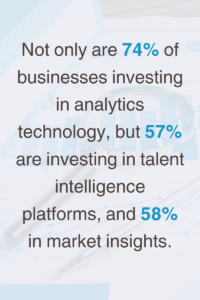The best way for organizations to break through a challenging hiring market is by using data to make the most informed decisions.
By Zee Johnson
Recent hiring concerns have made TA leaders aware of the fact that their decisions don’t determine the market, the market determines their decisions. But instead of resting on their laurels, waiting for the right candidate to magically appear, organizations can turn to labor supply and demand trends to help make the most informed, market-based hiring decisions.
 A LinkedIn report found that 87% of leaders think the TA function has become more strategic—and data is enabling that. A second report revealed that not only are 74% of businesses investing in analytics technology, but 57% are investing in talent intelligence platforms, and 58% in market insights.
A LinkedIn report found that 87% of leaders think the TA function has become more strategic—and data is enabling that. A second report revealed that not only are 74% of businesses investing in analytics technology, but 57% are investing in talent intelligence platforms, and 58% in market insights.
Carmen Scanlon, vice president of client solutions at WilsonHCG, says that these investments are increasing because having up-to-date metrics is the surest way to grasp talent obstacles and subsequently get around them. “Real-time labor market data enables leaders to better understand trends, challenges, and opportunities in the jobs market, and plan accordingly to build a workforce that is well-equipped to meet evolving business needs,” she says.
And these insights allow leaders to act almost immediately, which is critical, Scanlon says, because companies don’t have time to wait around for the talent they need. They should be leveraging key information in order to have a clear picture of the market and their competitors.
“Organizations can’t afford to wait several months for labor market data that’s become out of date by the time they’re able to gain access to it,”she says. “They need to be able to understand how much talent is out there, where it’s located, and what salaries they need to offer to ensure they’re competitive – today.”
There are a number of important data points that TA leaders should consider in their recruitment efforts. Some include:
- Labor supply and demand insights: to gain an understanding of the competitive landscape and to get ahead of industry shifts
- Employee movements: to understand where companies are winning and losing talent
- Salary trends: to adjust compensation and location strategies to local market conditions or talent scarcity
- Diversity, equity, and inclusion (DEI) insights: to accelerate and strengthen DEI strategies through labor market intelligence
All in all, data is critical to building a well-equipped workforce that will meet evolving business needs.














